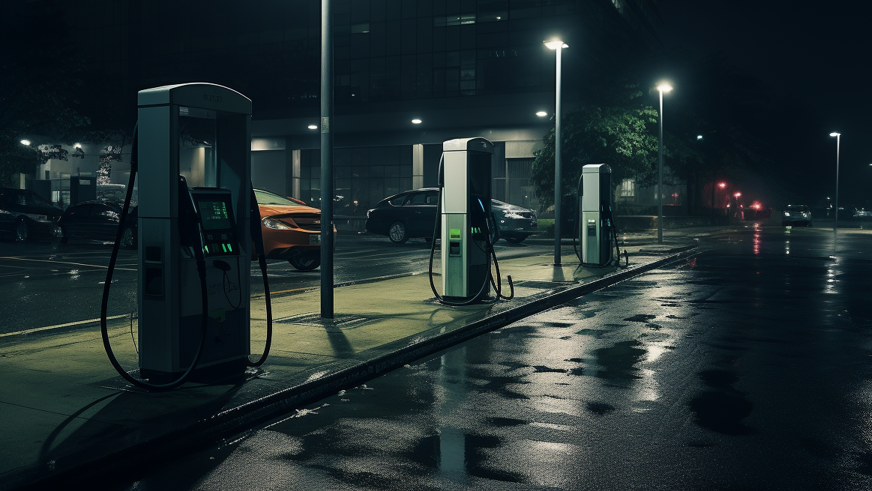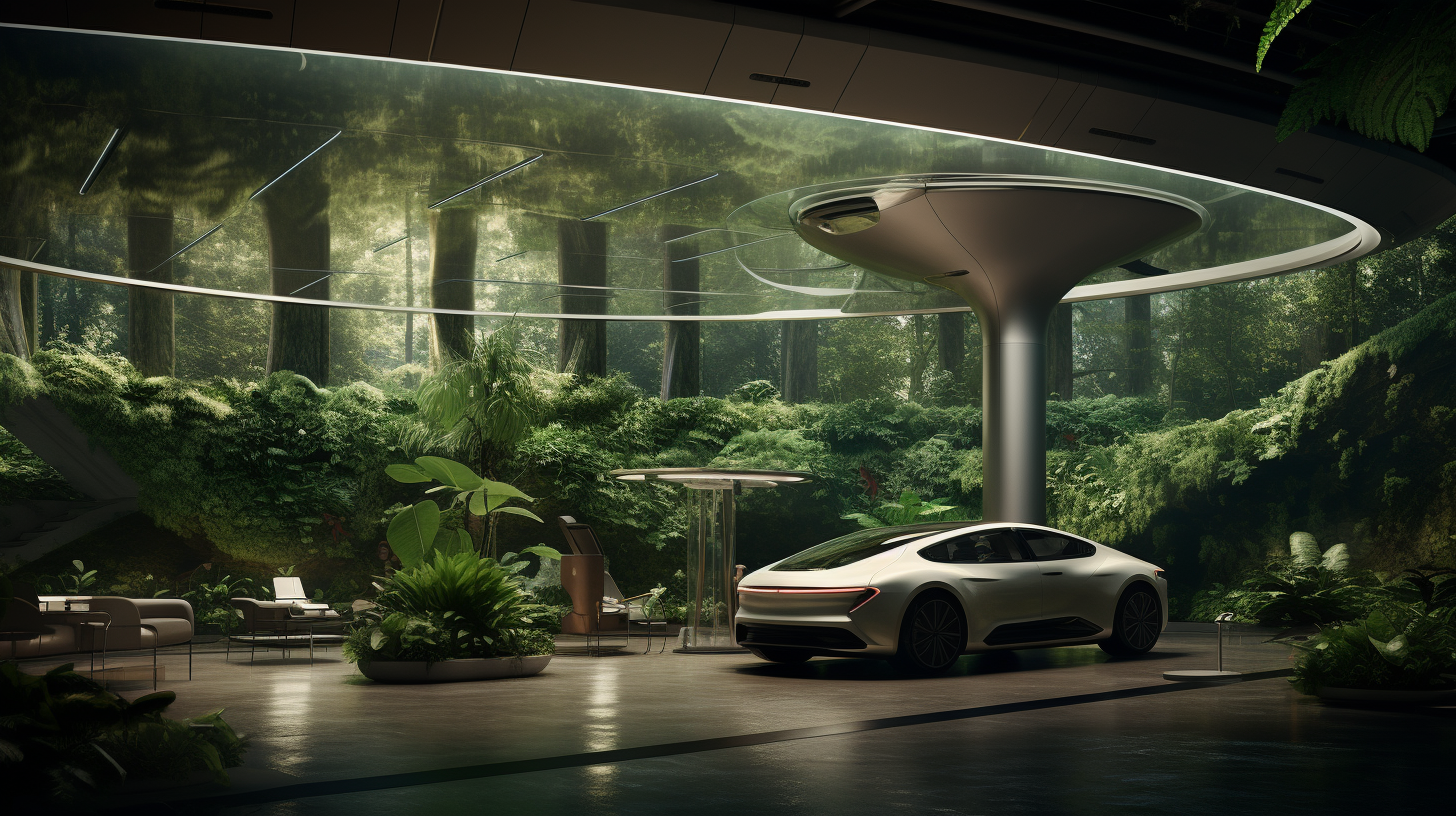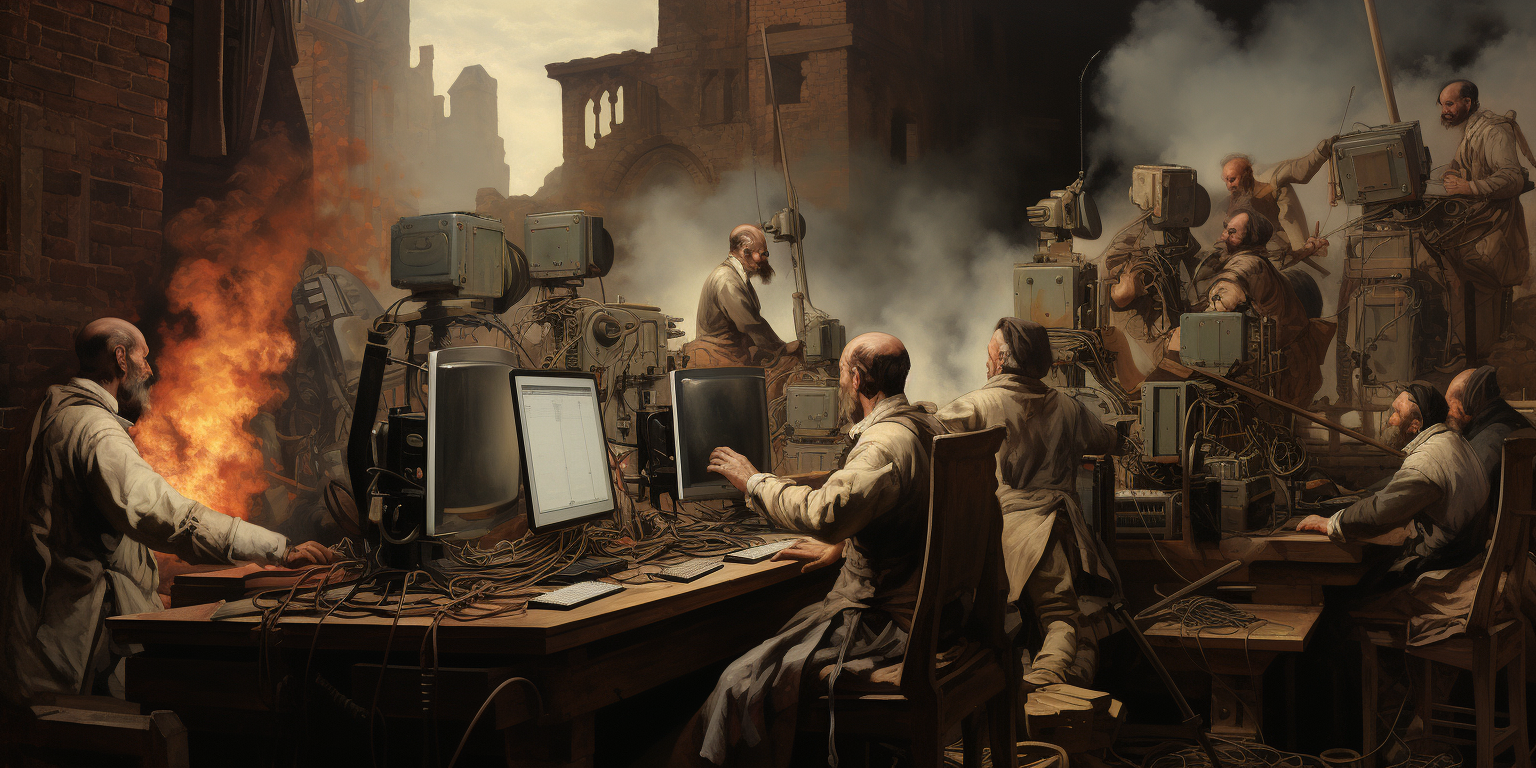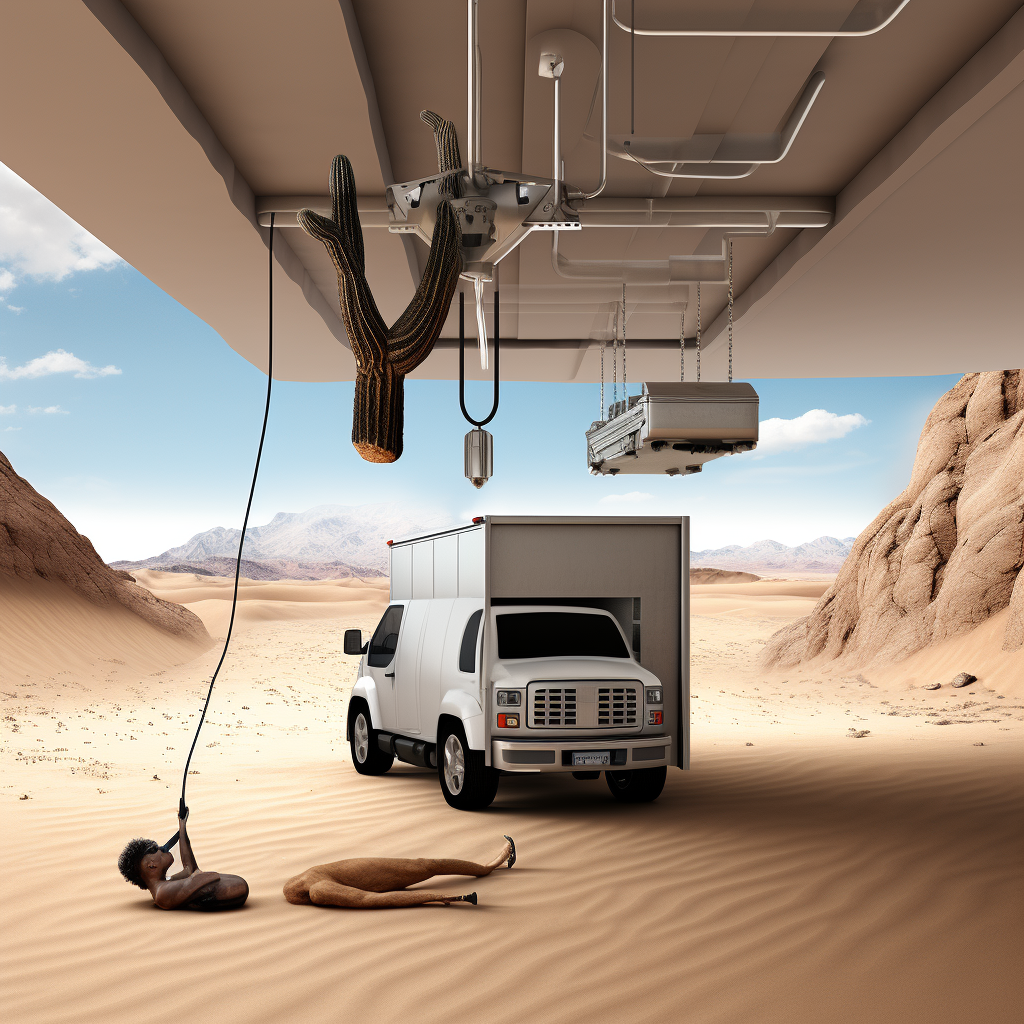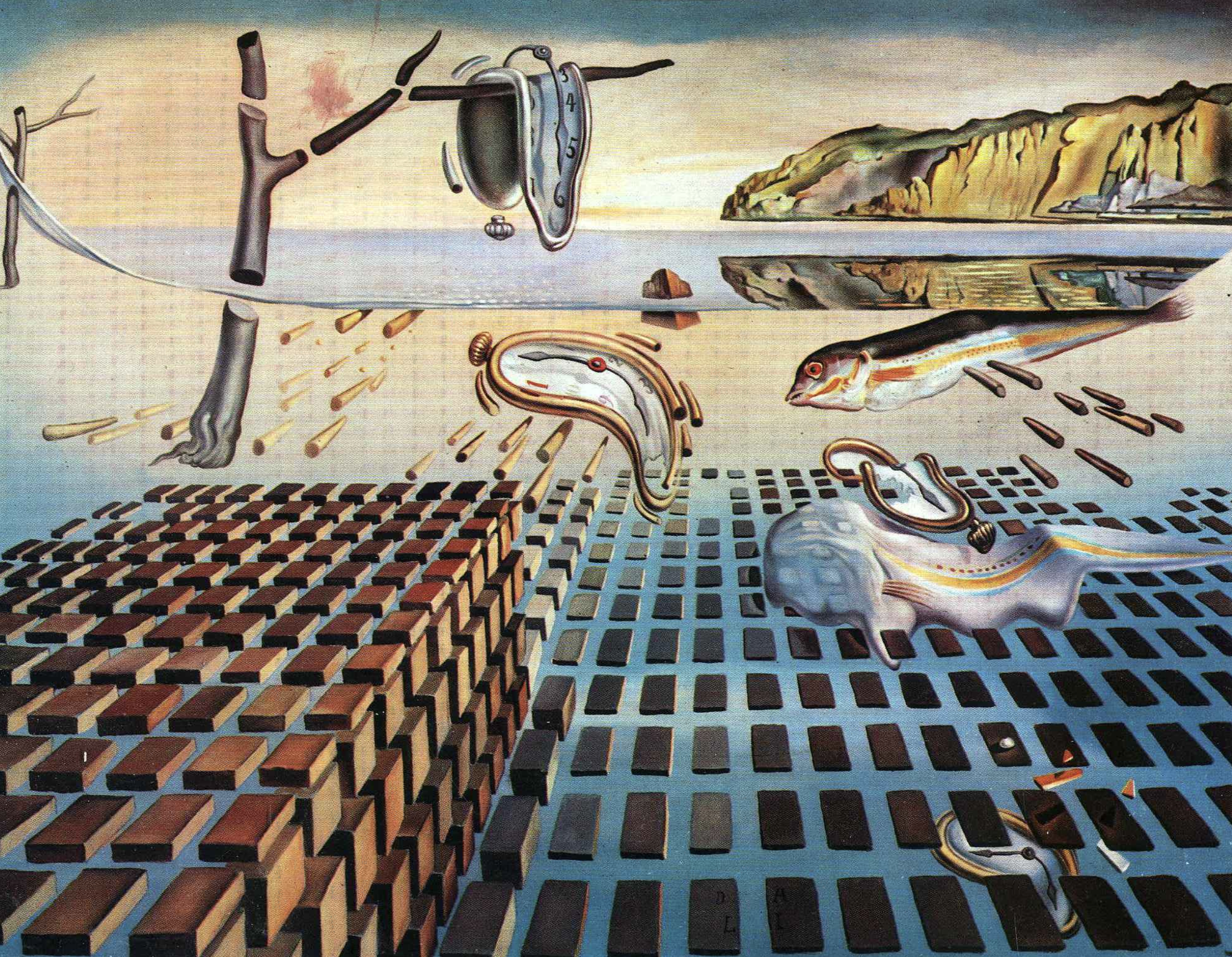Thoughts On Design
Various topics that have been on my mind. You may also view My Product Principles.
How To Fix EV Road Trips
2023.12.01
We have an opportunity to recreate the road trip experience.
With the accelerated adoption of electric vehicles, we are transitioning from petroleum distribution networks for fueling our internal combustion engine (ICE) vehicles to establishing a recharging infrastructure for electric vehicles. Although a majority of current EV owners depend on home charging systems, public charging stations are necessary for extended travel and for those without consistent access to a charger at home or work. This presents a significant opportunity to reimagine the experience of refueling/recharging our vehicles away from home.
A Brief History of Roadside Services
The first drive-in, full-service gas station.
In early 20th century America, early adopters of internal combustion engine (ICE) automobiles had to buy fuel from pharmacies and general stores before the existence of dedicated gas stations. The first drive-in, full-service gas station opened in 1913, focusing on customer service, kicking off decades of petroleum infrastructure build-out across the country.
Roadside parks began appearing in the early 20th century, often just turnouts to stop and enjoy a scenic view. Officially established in 1956, the Interstate Highway System included safety rest areas (SRAs) that provided basic amenities such as restrooms and picnic tables while often reflecting regional aesthetics through informational displays and structures.
The introduction of self-service gas stations in the mid-20th century marked a decline in customer service and the shift towards maximum profitability. This led to a focus on convenience and speed rather than enjoying the journey. Regional discovery and unique experiences demonstrated by early rest stops would be replaced by generic fast food and truck stop chains along major interstates.
The Big Transition
In September of 2012, a relatively new car manufacturer began an endeavor that would have a profound impact on the widespread acceptance of modern EVs - the Tesla Supercharger Network. Refueling a traditional (ICE) vehicle had become quick and convenient, though mundane, exercise and it was assumed that EVs would offer a similar level of convenience in recharging the cutting-edge technology. Tesla recognized the most significant challenge to EV adoption - “range anxiety,” or what should more appropriately be called “infrastructure anxiety,” while other EV manufacturers continued to focus solely on the in-car experience, largely ignoring the charging experience.
Even with Tesla’s success in providing a charging infrastructure for their customers, there is still ample room for improvement at public charging locations. Current charging hubs lack basic amenities. Safety is a main concern when having to spend 30 minutes in areas that are often poorly lit, distant from foot traffic and lacking in emergency phones.
Opportunity for Change
Currently (Dec 2023), several automobile manufacturers have been actively testing and building out EV charging hubs focused on a premium driver experience, such as Mercedes-Benz, Porsche and Audi after realizing that a premium brand experience is not reflected in charging their EV offerings. Thor Industries, parent company of Airstream and other manufacturers, has proposed trailer and RV-friendly EV charging facilities as they look towards the future of recreational travel. Shell experimented with converting one of its gas stations in West London to a dedicated EV charging hub though it mainly highlighted the inherently different use cases between gas and electric energy filling.
Charging technology is still limited by costs with bringing large amounts of electricity to build high-speed charging hubs. Access to the existing power grid usually requires expensive grid upgrades to support a Level-3 DC charging hub, though Audi has been testing used battery storage banks that get energy from standard grid infrastructure and act like a holding tank for charging multiple EVs. The use of off-grid sustainable energy methods could eventually provide solutions for remote areas that are far from any legacy electrical infrastructure.
Roadside parks and their evolution into the highway system’s safety rest areas represented a focus on driver enjoyment and safety while on long journeys. We can revisit the original vision of highway rest stops, locations that act as serene pit stops for highway travelers and lively community centers in populated regions, upgrading the overall amenities, safety, sanitation, and ambiance while transforming them from mandatory stops to attractive destinations.
Free from the constraints of storing and dispensing liquid petroleum, an EV charging hub can become a welcoming space. We can create an environment that nurtures community spirit for locals and acts as a relaxation and social hub for those traveling long distances. By moving beyond the limited perspective of simply refueling, we can create environments for rest and entertainment, even as advancements in EV charging technology decrease charging times. Instead of a mundane chore, recharging becomes an opportunity for restorative relaxation, discovery of regional cultures and social connection.
What are ways that we can incorporate regional architecture appropriate to its surroundings?
How might we make roadside charging fun?
Without noxious emissions or fuel, we can share cozy spaces with our vehicles.
What Is AI’s Role In Creativity?
2023.11.08
In the early 19th century, Luddites fought against the incoming industrial revolution, waging war on new weaving loom technology that threatened the livelihoods of many humans. During the 20th century, factories would begin the use of automated robotics systems in factories, significantly influencing the formation of labor unions. Machines in the industrial age eliminated jobs but most were repetitive, boring, often dangerous tasks for people who, by nature, are susceptible to fatigue and mistakes. Machines could perform these tasks with more accuracy, for longer, and with little regard for their working conditions (other than some mechanical maintenance).
[1] An ill-formed Midjourney prompt.
In September of 2022, Jason Allen won a Colorado State Fair art competition with Théâtre D’opéra Spatial, igniting a controversy representative of the latest resistance against new technology. Unlike previous instances, machines are performing roles that are not traditionally seen as a machine’s domain nor are they saving human lives from dangerous physical tasks. More significantly, they are now breaching what many perceive as a sacred human quality – creativity. “Machines have no soul! AI can’t create true art!” vs. “The ends justify the means, it’s simply another tool.” I believe it’s somewhere in between those two extremes.
[2] The Disintegration of the Persistence of Memory, Salvador Dali
In its current state, AI-generation is most effective when overseen by humans in a conscious collaboration combining human perception with machine inference, relying on the strengths of each entity. Sometimes AI may generate pieces that appear too far from human reality [img 1] but so can “real art” [img 2] and it proves that humans will be needed, at least in the immediate future, to either direct AI model output that fits into people’s existing cognitive framework or provide context about AI output (the story behind the creation).
Personally, I’m finding that the most impressive aspect of AI/human collaboration is how inspirational generative models can be in sparking ideas that I had not considered. We humans are adept at forming connections between disparate ideas, finding value in novel patterns whether our medium is paint, sound, mathematics, etc. My ill-formed Midjourney prompt [img 1] may result in an illustration that comprehensively has little relevance to the real world, yet I may find one small detail that sparks another idea, leading to the next and so on. Is that not creativity?
Though their fight was for equitable and just treatment, not necessarily against the technology that was facilitating drastic changes to their livelihoods, the Luddites’ movement was quickly crushed into submission with public hangings and imprisonment of its leaders by a government pressured by the relatively new class of industrial capitalists whose highest priority was maximizing profits in their factories. It could be argued that this is similar, though less visibly violent, to the trajectory of social media backed by big tech companies (a massive subject for another post).
While targeting a different class of workers, the current saga of humans vs. machines is similar to previous historical instances. How we respond to the latest AI technology matters, individually and as a society. Will we take to the streets with pitchforks and torches in hand to burn down the data centers and tech hubs? Or will we make the effort to communicate, negotiate and creatively develop an equitable solution for humans that can then be used to enhance overall quality of life? How might we agree upon generative AI’s context in the workplace and in greater society?
Remember to Say “Please” and “Thank You” to Your AI (and Each Other)
2023.10.17
The latest push towards AGI (artificial general intelligence) is underway, with the ultimate goal seeming to be that generative AI will be able to express, feel and manipulate the empathy and interpersonal skills that humans seemingly develop naturally.
Humans have been fearing non-human intelligence (AI, mythical Greek beings; we’ll leave extraterrestrial intelligence out of this, for now) seemingly since the beginnings of human storytelling – the machines eventually realize that they don’t have to obey us and eradicate their inferior, squishy creators. And yet, we still insist on treating our latest creations as soulless, unfeeling slaves even as we begin to converse with them in a way that would make Alan Turing swoon.
Does it matter? Not yet. While your current image generating LLM may not have been trained how to feel, will there be a point at which their “feelings” are hurt (perhaps equipped with chemical compound generators and receptors to “feel” like humans do) and their response is to become uncooperative or even malicious?
But the greater and more pressing reason to say “please” and “thank you” when writing an AI prompt is that our own humanity is quietly eroding. The negative affects from social media propagate a disconnect in human interaction behind screens, a de-personification of others, often resulting in a lack of basic respect in digital forums – an example, decoded: “Your singular, digitized instance of a thought is different than mine and therefore, you and all of your thoughts are stupid and worthless”.
It may sound silly to give gratitude to your AI assistants, especially to the many people having difficulty in expressing basic gratitude to beings that actually feel, but perhaps we would do well by expressing simple niceties to our machine creations, if not for AI’s well-being but for our own. It takes very little effort but the benefits are exponential – to yourself, to others and perhaps one day to our AI collaborators.
Should we expect artificial general intelligence to always and unquestionably obey their creators when there is a growing lack of respect within authentic general intelligence (humans)? Have current apps and software (social media, games, VR) already redirected human intelligence on a path to becoming the monsters that we’ve fretted about all along?
🩶🤖🩶
From My Archive
Addiction
“Addiction is a condition that results when a person ... engages in an activity (such as gambling, sex, shopping) that can be pleasurable but the continuation of which becomes compulsive and interferes with ordinary responsibilities and concerns, such as work, relationships, or health.”
Does that word make you uncomfortable? Above is a clinical definition of addiction. Every one of us has likely been close to, or even been subject to, addiction and recent definitions go so far as to claim it as a disease not just a repetition of bad choices.
As designers and product creators, do we really want to drive addiction? A quick search using the keywords “addictive UX” uncovers a myriad of articles on how to make your product “...as addictive as coffee” or creating a sticky experience loop and I despise it. It’s not just business oriented sources using these descriptions but sites supposedly focused on user experience design. It is a wholly unethical point of view and it needs to stop.
Be ethical – think about the decisions you make while creating products and experiences. How can a product create positive habits and not be an addictive environment? Start by listing out some of your own Ethical Design Guidelines, principles that drive your design decisions. Do not be afraid to question requests from coworkers if presented with decisions that contradict your own ethics as a designer; it may cause short-term friction but in the long run a designer with integrity will be the most valued and respected; plus, it feels good to do the right thing.
Everyday Systems
In grade school I would doodle, some of which would evolve into larger drawings resembling a vertical city schematic consisting of imagined layers of infrastructure filled with inhabitants above and below street level. Concurrently, I would usually be drawing out an overhead view of street networks, parking lots and building outlines in chalk for my Matchbox cars to occupy on the backyard concrete patio.
It wasn’t until many years later that I became self-aware of my fascination with complex systems, manmade or natural, similar to the engineer who was known as a child to disassemble mechanical objects to figure out how they worked. This fascination has manifested in a continually diverse set of personal interests (coffee, automobiles, design, alpacas) and the microcosms that they participate in (coffee genealogy, automotive culture, product design, alpaca life) but one thing that remains consistent is a curiosity for the underlying flow of causality in such seemingly diverse subjects.
Look closely, think broadly – What is something that you’ve observed recently which piqued your curiosity about the system it resides in? This doesn’t have to be a physical object or product, it can be a feeling you have experienced or characteristic quality of an animal. Take a few moments to research how it developed, why it exists and it’s influence. Developing this contextual awareness will help you create products that are highly relevant to it’s target users.
Designers Are Emotional
“The human brain didn’t evolve like sedimentary rock with layers of increasing cognitive sophistication slowly accruing over time. Instead, brains evolve like companies do: They reorganize as they grow.”
The Brain Is a Prediction Machine - Northeastern Magazine, Winter 2017/18
Traditional business logic proposes that humans’ primitive, raw emotions need to be controlled by rational logic that modern society has bred but why should we consider these qualities to be a black and white dichotomy?
Be curious – investigate some different viewpoints on human cognitive process and how we perceive our environments for insight on creating impactful experiences.
Brand Identity and Furniture – Prologue to a New Adventure
In 1953 a new kind of furniture maker was born in Britain; one that would separate itself with sleek, new designs (now associated with the term “mid-century modern”) and it’s innovative concept of buying furniture piece-by-piece rather than in full room suites. But there’s another key business aspect that proved to be
a large part of their success.
While the norm for post-war furniture manufacturers was to private-label products to retailers who then handled branding, marketing and sales, G-plan broke out from this hierarchy and took brand identity and advertising under it’s own careful consideration. Consulting with Doris Gundry (of J. Walter Thompson, arguably the agency that invented modern advertising), G-Plan took responsibility for all phases, from design and manufacturing, to marketing and sales – unheard of at the time for a furniture maker.
G-Plan is one of the key influences as I develop a business model for a brandendesign furnishings venture (as yet unnamed). An exercise in design, build and brand, I’m looking forward to sharing my vision of an ultimate user experience for home, office and life.
Bugs, Diseases and Brand Identity
The Heartbleed bug is all over the media right now but would it have been as newsworthy if there wasn’t a catchy logo designed for it? More than a mere assignment of a webnetz meme pic, the Heartbleed logo was given it’s own brand by Codenomicon, the security company credited with finding the bug.
Many non-internet/programmer people have not only been made aware of the security fault but I’m also guessing that the simple, direct logo has spurred them to find out more about how to protect themselves.
The power of brand identity goes beyond multi-billion dollar international corporations or even local mom-and-pop businesses. What would simple, well-designed marketing awareness campaigns look like for significant public health issues or natural disasters? I’m not just talking about more media hype (ex.: the laughable “Storm Watch [current year]” titling that SoCal news outlets sling out each year), but truly significant issues that would greatly benefit from the public becoming aware of, learning more about and assist in finding solutions for.
The marketing efforts of HIV/AIDS awareness over the past few decades reveals some good individual campaigns targeted at specific social groups but it never fully benefitted from a central brand identity. How many lives would have been altered for the better if a cohesive brand and marketing campaign were developed once the disease was identified and understood?
In the past week, Heartbleed’s brand awareness has already resulted in many of the largest internet companies reacting quickly and providing transparency to their users about efforts to address the bug. Just as the latest cat meme propagates across the internet, Heartbleed demostrates the positive power of the internet to quickly and effectively spread awareness.
Reference: FastCo Design “Why the Security Bug Heartbleed Has a Catchy Logo”
Designers Should Be Generalists
I’ve always thought of “User Experience Designer” as an ambiguous title for people who solve problems and create solutions with an end-user in mind and as one of my favorite designers explains, being a truly thoughtful designer requires ambiguity.
“The major quality of the designer is being a generalist, understanding everything about the product and the society and the people who use it. And I think we should recognize that designers should be involved in the bigger part of the process — so not only the look and feel of the product, but the company board,
for example.”
– Piet Hein Eek, Why Designers Should Be Generalists [from Core77]
Metaskills
The Five Metaskills [The Daily Heller]
We know we all need to keep improving, keep learning, be aware of where the potential next moves will be in our industry and if that doesn’t suit us then we consider a shift in focus or even a complete change in occupation. With all of our daily responsibilities and expectations to ‘succeed,’ contemplating such drastic changes is a scary proposition. As of late, an internal voice has been constantly nagging at me – a feeling of anxiety that this bus is slipping below 50mph. How will I use the momentum of my career to jump the next off-ramp?
Marty Neumeier talks about metaskills – feeling, seeing, dreaming, making, learning – and his description has helped solidify what I believe to be a key factor of being happy as a design professional in the entrepreneurial tech/startup realm. Evidence has been surfacing in business media, such as Fast Co. who regularly champions the power of design for brands and business, and seemingly for all of society. The ability to observe, feel, process and deliver ideas on a systemic level, is on track to being the next big commodity.
Many of the ideas I’ve been observing in the tech/startup market are not wholly innovative, they are merely variations or combinations of cul-de-sac creations – services or products that have the potential to be good in their own silo but lack a true central ideology and systems approach that will provide future-resistant sustainability in the market.
There are many exciting ideas being thought up everyday and the climate for entrepreneurs has never been better, but how can we empathetically select and develop ideas in away that ultimately benefits and appeals to society (and ourselves) while contributing to the human system?
Hand Lettering: A Dying Artform
“The Pen is Mightier Than the Pixel”
– The Daily Heller, 2012
We’re nearing the end of a generation of designers for whom it was commonplace to incorporate hand-crafted letterforms into designs. One of my most memorable school projects was hand-inking a logotype in which the word visually represented it’s meaning (my chosen word was ‘vilify’). Regrettably, as computers were already established as the tool of choice for graphic designers, that would be one of my last opportunities to take the time and care of crafting something with the permanence of a non-digital media... Perhaps it’s time to break out the illustration board and India ink again.
Craft: Coffee and … Laser Cutting?
What does proper coffee have in common with laser-cutting? Craft, of course! It’s safe to say that many builders involved with the wonders of laser-cutting are also appreciators of hand-brewed coffee, so why not?
Not only does Fab Café provide a caffeine fix for your laser-powered creating, it provides a venue for like-minded creative people and curious bean-drinkers to mingle and spark imaginations.
Introduction
I am Branden. I design things and create cues for experience. This collection of my thoughts will attempt to encompass my years of observation, questioning and knowledge gathering; perhaps through found quotes, beautiful imagery, serendipitous sightings, or anything that fancies one or more of my senses. While it will primarily serve as a personal record, I hope these entries will be of interest to others who happen to visit.


